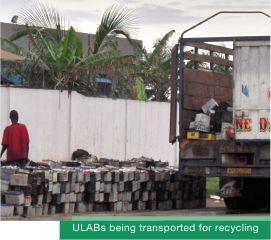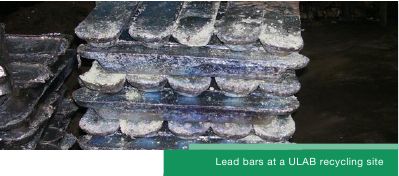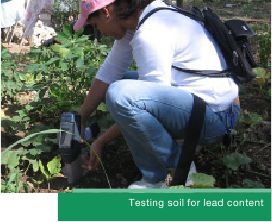Lead
Estimated Population At Risk At Identified Sites:
10 Million People
Estimated Global Impact:
18 to 22 Million People
Introduction
 Lead is a toxic heavy metal that affects the lives of
millions of people every year. Lead occurs naturally
in the Earth’s crust and is mined for use in products
such as pigment in paints, dyes and ceramic glazes;
caulk; pesticides; ammunition; pipes; weights;
cable covers; car batteries; and sheets to protect
people from radiation. Lead is often combined with
other metals to form alloys, and, until recently, was
commonly added to gasoline to increase octane
ratings.
Lead is a toxic heavy metal that affects the lives of
millions of people every year. Lead occurs naturally
in the Earth’s crust and is mined for use in products
such as pigment in paints, dyes and ceramic glazes;
caulk; pesticides; ammunition; pipes; weights;
cable covers; car batteries; and sheets to protect
people from radiation. Lead is often combined with
other metals to form alloys, and, until recently, was
commonly added to gasoline to increase octane
ratings.
Environmental levels of lead have been increasing for hundreds of years, and are only just starting to decrease in response to greater awareness of its harmful effects. Today, much of the lead in circulation exists in car batteries, also called used lead-acid batteries (ULAB). Of the six million tons of lead that are used annually, approximately three quarters go into the production of lead-acid batteries. [1] Of these batteries, 97% are eventually recycled to retrieve the lead. [2] The high levels of recycling are, in part, due to the increase in lead prices over the last 15 years.
In low- and middle-income countries, common industrial sources of lead pollution include mining, primary and secondary metal smelting, steal and iron production, car battery recycling, and the production of pigments. Lead that is released into the air is brought back to Earth by precipitation or as particulate matter falling to land or surface water. Once lead reaches the top layer of soil, it tends to adsorb to soil particles that can be blown around as dust or be tracked throughout a community by people walking in the impacted area. The lead in the soil can also reach surface water bodies as part of storm water runoff. Water movement through the soil can transport lead to ground water, which is used for drinking water and crop irrigation.
Lead often enters the environment through releases during the mining process for lead and other metals, as well as from factories that make, use, or recycle lead or lead compounds. Lead can also be released into the air by burning coal, oil, or lead-containing waste. Once lead is on the ground it can remain in the upper layer of soil for many years. Lead can migrate into ground water supplies, particularly in areas that receive acidic or “soft” rainwater. Furthermore, levels of lead can build up in plants and animals when the surrounding environment is contaminated.
Common Exposure Pathways and Health Risks
 Lead typically enters the body through ingestion,
inhalation, or by mother-to-child transmission in-
utero or via breast milk. Although it is possible for
lead to enter the body through contact with skin,
this pathway is not commonly associated with high
concentrations in the body. Once lead enters the
body, it moves from the blood to the soft tissues and
organs, and eventually reaches the bones and teeth.
Lead can be stored in bone for up to 30 years. [3]
Lead typically enters the body through ingestion,
inhalation, or by mother-to-child transmission in-
utero or via breast milk. Although it is possible for
lead to enter the body through contact with skin,
this pathway is not commonly associated with high
concentrations in the body. Once lead enters the
body, it moves from the blood to the soft tissues and
organs, and eventually reaches the bones and teeth.
Lead can be stored in bone for up to 30 years. [3]
The health effects of lead poisoning are both acute and chronic, and are particularly severe in children, the most exposed group. [4] These adverse impacts can include neurological damage, reduced IQ, anemia, muscle and joint pain, loss of memory and concentration, nerve disorders, infertility, increased blood pressure, and chronic headaches. because of their smaller size, even small amounts of lead in the bodies of children can be associated with longterm neurological and cognitive defects. When women who are pregnant are exposed to lead, it can result in damage to the fetus and eventual birth defects. At high concentrations, lead poisoning can cause seizures and death.
Acute lead poisoning commonly results from people inhaling lead particles in dust or through ingestion of lead-contaminated dirt. [5] This was the case around the Haina ULAB recycling facility Haina in the Dominican Republic, where at least 28% of children required immediate treatment for lead exposure, and 5% had blood-lead levels that put them at risk for neurological damage. [6]
The extraordinary danger that lead poses was recently highlighted by a catastrophe in Dakar, Senegal, where between November 2007 and March 2008, 18 children died from acute lead poisoning due to lead dust and soil exposure from ULAB recycling. Until the contamination was discovered, the main economic activity in the Dakar community of Thiaroye Sur Mer was ULAB recycling. Initial tests of children living in the area found an average blood-lead level of 129.5 µg/dL, drastically exceeding the United States Centers for Disease Control and Prevention action level of 10 µg/dL. [7]
Industrial Sources of Lead Pollution - ULAB Recycling
Industry Overview
Lead-acid batteries are the oldest form of rechargeable battery. These simple electrochemical units are composed of lead plates that rest in a bath of sulfuric acid that is contained within a polypropylene or polyethylene plastic casing. Because of their large power-to-weight ratio and low costs, lead-acid batteries are extremely common in motor devices, and thus are frequently referred to as “car batteries.”
 Although these batteries can be charged multiple times, eventually this cycle places stress on the lead
Although these batteries can be charged multiple times, eventually this cycle places stress on the lead
plates, which begin to deteriorate. Over the course of multiple recharges, the unit can no longer properly store energy for a prolonged period. However, because of variation in the unit’s production and operating conditions, there is no set number of recharges one battery can take before its use is compromised. [8] Once units cease to be effective, they are often sent to a ULAB recycler.
Of the total volume of lead used annually, 76% goes toward the production of lead-acid batteries. [9] Recycled lead is a valuable commodity, and the recovery of lead from ULABs can be a significant source of income. The market for reclaiming lead from these batteries has been growing globally, especially in many low- and middle-income countries. In order to make a profitable business from recovered lead, many of these countries have entered into the business of buying these units in bulk. The batteries are often shipped over long distances, primarily from high-income countries, that produce, use, and collect the spent batteries for reprocessing. [10]
Several factors have heightened the risks posed by ULAB recycling. One factor that compounds ULAB risks is the increase in population density in urban centers in low- and middle-income countries where informal recycling takes place. In addition, the cumulative effect of high unemployment rates and increased car ownership has lead to the proliferation of informal ULAB recycling. Currently, ULAB recycling occurs in almost every city in low- and middle-income countries. In addition to being located in these densely populated urban regions, ULAB recycling and smelting operations are often performed with few environmental safety controls and with little understanding of the risks involved.
According to the Basel Convention on the Control of Transboundary Movements of Hazardous Wastes and Their Disposal—an international treaty designed to reduce the movement of hazardous wastes to low- and middle-income countries—ULABs are a dangerous source of pollution. [11] When the recycling operation is informal and small-scale, recyclers often break batteries open by hand or with an axe. In many cases, informal battery recycling is a subsistence activity undertaken in homes and backyards.
Because global demand for lead is high, ULAB recycling is an economically valuable activity and a large source of recycled lead. This high level of recycling effectively reduces the volume of lead dumped into landfills and minimizes the need to mine lead ore, but it also leads to dangerous conditions around recycling facilities. The lack of education about health risks, combined with a lack of resources, leads to dangerous working conditions at ULAB recycling facilities and severe health risks to local populations.
Exposure Pathways from ULAB Sites
Occupational exposure to lead is common in the informal ULAB recycling business. In the most common scenario, the battery acid—which contains particulates of lead—is dumped on the ground, in a waste pile, or in local water sources. As the valuable lead plates from within the unit are melted, lead ash is emitted into the air and can be inhaled or gather on clothing and surfaces. One study in Pakistan found that children of lead recyclers were more at risk of lead overexposure than other groups, indicating that the probable source of the exposure was dust on the parents’ clothing brought in from work. [12]
In general, children are at high risk of exposure to lead at ULAB sites. They often come into contact with lead when playing on the waste furnace slag and when handling rocks or dirt containing the heavy metal. Their close proximity to the ground means that children have more interaction with contaminated soil and dust. The most common route of exposure for children is ingestion, as lead dust often covers clothing, food, soil, and toys where individuals eat, sleep, and play. Exposure to contaminated water is another pathway for lead from ULAB recyclers to enter the body. In Trinidad, most of the existing cases of lead poisoning in children stem from contaminated surface and groundwater used for bathing, drinking, and cooking. [13]
What is Being Done
 Blacksmith Institute is implementing cost-effective remediation projects at ULAB recycling sites in the Dominican Republic, Senegal, Jakarta, Manila, and other locations around the world. The efforts focus on eliminating exposure to lead from informal ULAB recycling through several steps. These steps include: monitoring lead levels in blood (primarily in children); partnering with local governments, NGOs, and community leaders to conduct education programs about the dangers of lead poisoning and ULAB recycling; excavating contaminated soil and removing toxic soil and dust in and around homes; and either formalizing the recycling process or providing other sources of income for those who previously have depended on this activity.
Blacksmith Institute is implementing cost-effective remediation projects at ULAB recycling sites in the Dominican Republic, Senegal, Jakarta, Manila, and other locations around the world. The efforts focus on eliminating exposure to lead from informal ULAB recycling through several steps. These steps include: monitoring lead levels in blood (primarily in children); partnering with local governments, NGOs, and community leaders to conduct education programs about the dangers of lead poisoning and ULAB recycling; excavating contaminated soil and removing toxic soil and dust in and around homes; and either formalizing the recycling process or providing other sources of income for those who previously have depended on this activity.
Footnotes:
[1]: H. Roberts. “Changing Patterns in Global Lead Supply and Demand.” Journal of Power Sources 116.1-2, (2003): 23–31.
[2]: U.S. Department of Health and Human Services. “Toxicological Profile for Lead.” Georgia: Agency for Toxic Substances and Disease Registry, 2007.
[3] Ibid.
[4] B. Kaul and H. Mukerjee. “Elevated Blood Lead and Erythrocyte Protoporphyrin Levels of Children near a Battery-Recycling Plant in Haina, Dominican Republic.” International Journal of Occupational and Environmental Health 5.4, 1999.
[5] United Nations Environment Programme. “New Basel Guidelines to Improve Recycling of Old Batteries.” Available at http://www.unep.org/Documents. Multilingual/Default.asp?DocumentID=248&ArticleID=3069&l=en, May 22, 2002.
[6] B. Kaul, et al. “Follow-up Screening of Lead-Poisoned Children near an Auto Battery Recycling Plant, Haina, Dominican Republic.” Environmental Health Perspectives 107.11 (1999): 917–920.
[7] P. Haefliger, et al. “Mass Lead Intoxication from Informal Used Lead-Acid Battery Recycling in Dakar, Senegal.” Environmental Health Perspectives 117.10 (2009): 1535–1540.
[8] Department of the Environment and Heritage. “Used Lead Acid Batteries: Factsheet.” Australian Government. Available at http://www.environment.gov.au/settlements/chemicals/hazardous-waste/publications/lead-acid-fs.html, August 2005.
[9] H. Roberts. “Changing Patterns in Global Lead Supply and Demand.” Journal of Power Sources 116.1-2, (2003): 23–31.
[10] Trade and Environment. “A Teaching Case: The Basel Ban And Batteries.” Available at http://www.commercialdiplomacy.org/case_study/case_batteries.htm, 2002.
[11] Basel Convention. United Nations Environmental Programme. “The Basel Convention at a Glance.” Available at http://www.basel.int/convention/bc_glance.pdf, 2005.
[12] D.A. Khan, et al. “Lead Exposure and its Adverse Health Effects among Occupational Worker’s Children.” Toxicology and Industrial Health, 2010.
[13] T.I. Mohammed, I. Chang-Yen, and I. Bekele. “Lead Pollution in East Trinidad Resulting from Lead Recycling and Smelting Activities.” Environmental Geochemistry and Health 18.3 (1996): 123–128.




